I never throw away glass. I’m a glass artist, and you just never know when a plate, jar or even a soda bottle might make the perfect addition to your next project. This crafty homemade bird feeder cost me just a few dollars, and now I’m sharing my secret with you. All you’ll need are patience and a couple of hours to make your own. Then sit back and watch while the birds enjoy their treats! Psst—here’s the 10 types of bird feeders you need in your backyard.
Tip: Don’t be afraid to work with glass. With the right tools and a little practice, you can recycle all types of glass into useful new things.
Materials:
- Glass soda bottle with cap
- 1/4-in. threaded steel rod, 12 in. long
- 7-1/4 x 7-1/2-in. turnbuckle with two eyebolts
- Loctite glue
- Chicken feeder base (available at feed stores)
- Washer
- 1/4-in. threaded wing nut
- G-hook
- 1-in. diamond drill bit
- 1/2-in. regular twist drill bit
Step-By-Step Instructions:
Step 1
Glass soda bottles aren’t hard to find these days. Mexican Coca-Cola is usually sold this way, and it’s readily available across the United States. Once you have the bottle (I used a 1-liter bottle), find something to hold the neck to keep it in place. I find the garbage disposal in my kitchen sink ideal for this.
Next, under running water, use a 1-in. diamond drill bit to make a hole in the bottom of the bottle. This is the most difficult part of the project. It’s important to keep your drill bit and glass cool by immersing them in water; overheating can break the bottle and even ruin your bit. Start at an angle, gently holding the drill bit in place. Once the drill bit has made a groove in the glass, straighten the bit up so that it hits all sides of the hole evenly. Run your drill at a slow speed to start out, speeding up as the bit becomes deeper, then slowing down toward the end. Once you’ve made the hole, you may need to file off the sharp edges; an emery board will do.
Step 2
With the 1/2-in. drill bit, drill a hole in the center of the chicken feeder base and Coke bottle cap.
Step 3
Connect the turnbuckle and the steel rod by removing one of the eye hooks from the turnbuckle and screwing the rod into place. Once you’ve determined that you have the correct length, you can use a drop or two of Loctite to keep it from moving, but don’t do this until you have put it together successfully at least once.
Taking out the other eye hook, place it through the drilled hole in the bottle cap and screw it back into the turnbuckle. The eye of the eyebolt will be on top of the cap for your hanging hook to thread through.
Step 4
Feed the steel rod through the top of the bottle, past the hole in the bottom of the bottle and then through the hole in the chicken feeder. Firmly press the bottle cap down on the lip of the bottle.
Holding the feeder upside down, place the washer over the threaded rod. Screw the wing nut in place.
Step 5
Attach a hook. I use a G-hook, but you may choose a different type depending on where you want to hang it.
Once you’re ready to fill your bird feeder, simply take the bottom off, fill with your favorite birdseed and reattach the bottom.
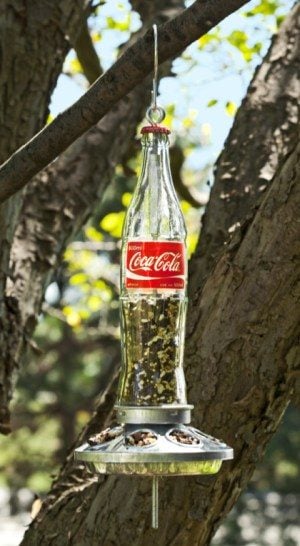

Pick Your Perfect Size
Pines come in a variety of sizes. Low-mounding dwarf forms top out at 1 foot, while mature white pines can soar to 150 feet or more. These 10 dwarf conifers are perfect for filling a small space.
The Difference Between Pines and Conifers
All pine trees are conifers, but not all conifers are pine trees. To tell if you’re looking at a pine tree, see if the needles on the branches are bunched together. Most pines have needles in small groups of two to five. Check out the best types of conifer trees and how to grow them.
One Bird Shares Its Name With a Pine
The pinyon jay is named after one of its favorite food sources: pinyon pine seeds. Find out more about the jay family of birds—and how to attract them to your yard.
Pine Cones Are Strong
Some pine cones have staying power, and hold on to their branches for more than 10 years. Have little ones help you make a DIY pine cone bird feeder!
Grow Your Own Nuts
You can grow and harvest pine nuts from your own tree, although it could take up to 15 years to mature. Psst—learn how to grow your own birdseed.
A Very Special Pine
Nicknamed “Phalanx,” a ponderosa pine in Oregon is one of the tallest in the world at 268 feet.
Certain Pines Have Long Needles
Longleaf pine’s dark green needles grow in groups of three, each needle reaching 9 inches or longer.
Next, learn fun facts about Christmas trees.

Yellow Leaves on Plants
Start by evaluating your regular watering habits. Watering too frequently or infrequently can cause leaves to yellow. Tropical plants prefer moist soil, while cacti and succulents like the soil to go dry between watering. Always use your finger to check the top 1 or 2 inches of soil for moisture before watering.
Increase success by using containers with drainage holes or self-watering pots with weep holes that allow excess water to escape. Pour off any water that collects in the saucer to avoid root rot, or place pebbles in the saucer to elevate the pot above the excess water.
Mites, aphids and scale pests suck plant juices, causing the leaves to yellow and turn brown. A strong blast of water dislodges many of the insects. A couple of applications of insecticidal soap will also manage these pests and immature scale insects. Organic horticulture oil labeled for use on houseplants is effective at controlling pests at all stages.
Check out the top 10 best houseplants for low light.
How to Fertilize Indoor Plants
Once you rule out improper watering, it’s time to review your fertilization schedule. Let the plants be your guide. Pale, stunted or yellow leaves may mean the plants need a nutrient boost. Use a diluted solution of houseplant fertilizer and only fertilize actively growing plants from spring through early fall, even if they’re always indoors.
Next, learn how to prevent brown tips on the leaves and brown spots on the leaves.
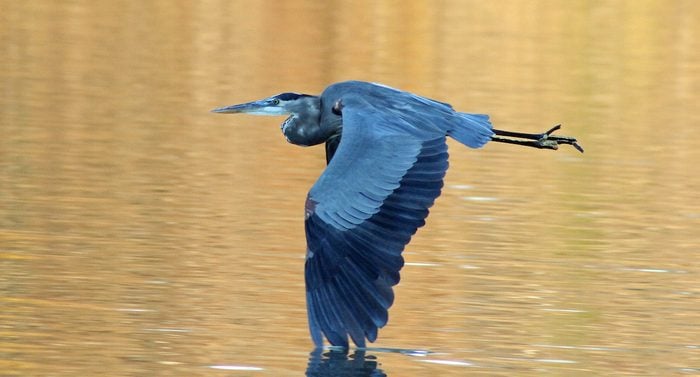
Do Great Blue Herons Migrate?
“Is it normal for a great blue heron not to migrate? There’s one still fishing in our backyard pond,” writes Marion Lambert of Lyndonville, New York.
It’s true that most great blue herons migrate to warmer climates in winter, but a few will remain far to the north, especially where some open water gives them access to fish, frogs and other aquatic prey. If the water is temporarily frozen, they may survive by catching mice and other small animals. Staying north is a gamble that doesn’t always end well for these lingering birds, but on the other hand, they avoid the perils of migration by remaining where they are. Sometimes the risk pays off. Check out the top birding hotspots for fall migration.
Great Blue Heron Size
The great blue heron is the largest heron species in North America, standing about 4 feet tall. But even though they are large birds, they don’t weigh much (only 5 to 6 pounds), thanks to their light, hollow bones (a trait most birds have). Learn about the 10 egrets and herons found in North America.
Great Blue Heron Nest
Nests vary widely. A first-year nest may be only 20 inches across. Others, used repeatedly for many years, can reach 4 feet in diameter and nearly as deep. A great blue heron colony might have more than 500 nests. Learn about 8 different kinds of bird nests and how to spot them.
How Fast Do Herons Fly?
For such large and lanky birds, herons are speedy, flying as fast as 30 mph. They usually fly with their necks in an S-shape and their legs trailing behind them. Check out fascinating facts about wading birds.
What Do Great Blue Herons Eat?
With a lightning fast strike, herons easily nab fish or frogs for a meal. Discover 7 backyard birds that eat berries.
Great Blue Heron Call
One part of the great blue heron that’s not beautiful is its call. The rough squawk has a guttural, almost prehistoric sound to it. Learn what a cardinal’s call sound like.
Do Males and Females Look Alike?
Great blue herons are one of the most beautiful birds in America. The male and female look almost exactly the same. On average, males are a little larger with longer ornamental plumes, but these distinctions are so slight and variable that it’s hard to see the difference, even when members of a pair are together. And pairs are together only when they are on the nest. That’s where they do their courtship and all their interactions around raising their young. When they fly off to find food for themselves and their young, they go separately, not together.
If you’ve never seen an owl in your backyard, that doesn’t mean one isn’t there. These mysterious birds are nocturnal predators, so they hunt in the darkness after you’ve gone to bed. Their special feathers allow them to fly in complete silence, making owls even more difficult to hear than they are to spot in trees. Put on your detective’s cap and become a sharp-eyed owl observer.
How to Spot Owls in Trees
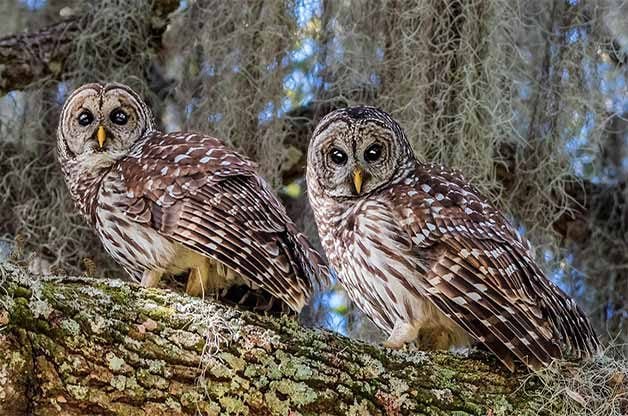
To spot an owl, stay up late and do some nocturnal wildlife-watching from the comfort of your deck or on your next camping trip. As human activity dies down for the evening and the smaller animals that owls prey on become active, you are more likely to spot one of these nighttime birds. Binoculars are a must for owl observation, and if you’re a birder, you probably have a set handy. If you don’t own a pair yet, there are plenty of high-quality, beginner binoculars to get you started.
Thanks to excellent camouflage, owls are still able to fly under the radar once the sun comes up. If you move quietly and scan patiently, you may be able to spot an owl on its daytime roost. Owls often roost in dense evergreens. They’ll also perch close to the trunk in other kinds of trees, where they’re easier to spot once autumn leaves fall. Some species roost inside tree cavities, and you may be able to spot them looking out of the holes on warm days.
Learn more about the owls of North America, your noctural neighbors.
Listen for Owl Sounds
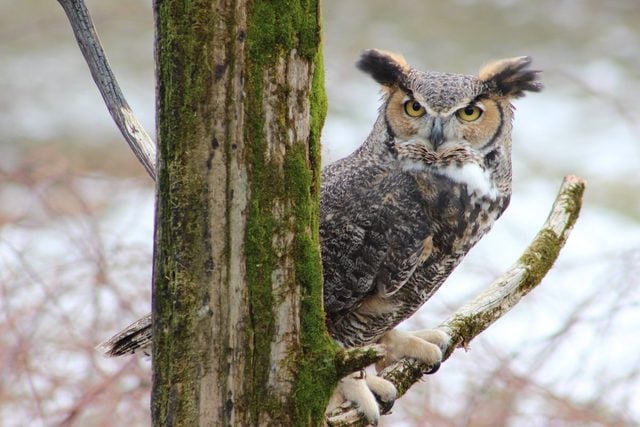
Even though it’s unlikely you’ll hear one of these birds of prey flapping its wings because of the silencing flight feathers, your ears are still some of your best tools for discovery. Owls can be quite vocal, and like other bird groups, different species have different calls. Owls in towns and cities are often less vocal than those in wild country. But late at night, after traffic quiets down, listen for them calling. Whether it’s the who-cooks-for-you of the barred owl, the ghostlike trilling of a screech-owl or the bold, classic hooting of a great horned owl, learning owl sounds and calls is one of the best things you can do to find more species in your neighborhood. Get your owl know-how rolling with the Cornell Lab of Ornithology’s website, allaboutbirds.org, which includes calls for each species and is a great educational resource for all types of identification.
Don’t miss these outstanding pictures of owls.
How to Find Owl Pellets and Feathers
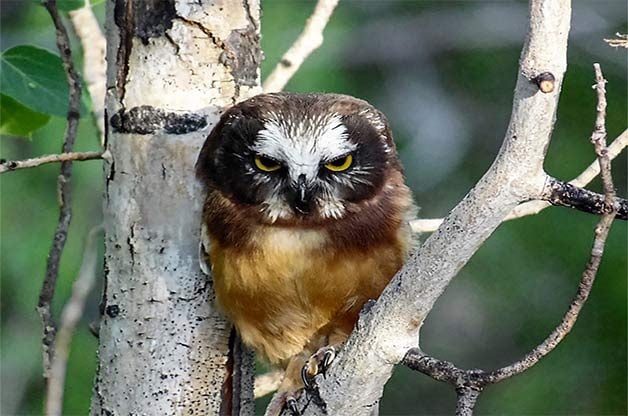
Beyond sight and sound, there are plenty of other ways to notice when an owl might be nearby. Like all birds, they molt their feathers and grow a new set every year. Be on the lookout for large feathers on the ground, and have a field guide handy to match your find with the correct species.
Owls also produce pellets—little balls of hair and bone that they regurgitate. Owls often swallow their food whole, later coughing up the indigestible parts. You may find owl pellets of matted fur, tiny bones, and insect scales under dense evergreens where the owls have roosted. These remainders are sure signs that owls are around. Scour the ground beneath trees for owl pellets, and if you’re really feeling adventurous, take one apart to learn what the owls in your neighborhood have been eating for dinner.
Additionally, once owls find a roosting spot, they may use it for several days. Their droppings accumulate as “whitewash” on the ground or on the tree trunk below their perch.
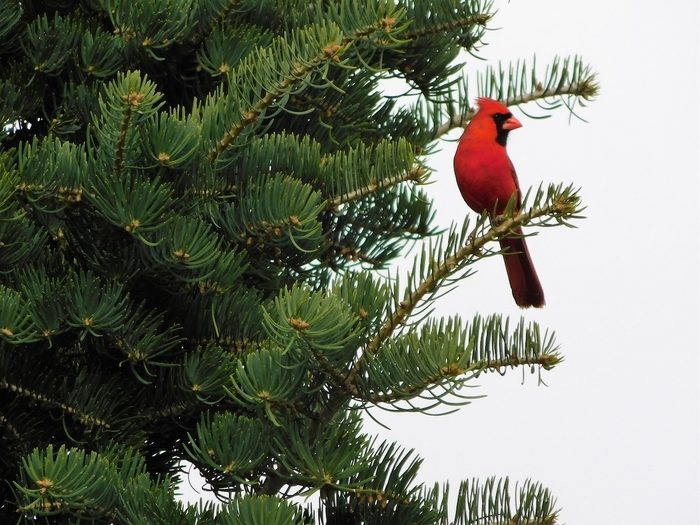
Conifers—thanks to their striking silhouettes, noteworthy growth habits, remarkable evergreen textures and variety of hues—are “gotta-have-it” landscape additions for today’s gardeners. Thankfully there are many types of conifer trees to choose from.
“People are really getting into conifers,” says landscape designer Geno Neri of Neri Landscaping in St. Charles, Illinois. “Homeowners like conifers for their ease of maintenance and year-round interest. And conifers work well with so many plants. Think of taller conifers as the bones—the exclamation points—of a garden. They give height and look good when nothing else is growing. But then, in spring, summer and fall, the conifers nicely showcase the texture of ornamental grasses, shrub foliage, and flowering annuals and perennials.”
Where to Plant Conifer Trees
Conifers are sure to attract attention no matter how and where you showcase their distinctive silhouettes. They’ll capture passersby’s curiosity as well as draw flocks of nesting birds that seek shelter and food amid their boughs. Depending on their type and size, conifers can be cultivated as specimen plants or as privacy hedges or combined with other conifers in rock gardens and foundation plantings. Their shapely contours make for arresting anchors amid perennial borders, while low-growing conifers with spreading forms stand in as good-looking ground covers.
“Conifers enable the gardener to create a rather amazing landscape,” says Rich Eyre, who, along with his wife, Susan, owns Rich’s Foxwillow Pines, a nursery in Woodstock, Illinois that specializes in dwarf conifers. “Conifers come in just about every color: green, yellow, blue, orange and purple. Some conifers are feathery; others have stiff needles. All conifers bear cones in assorted colors and shapes, with yews and junipers producing fleshy, berry-like cones. Conifers expand your planting palette and enable you to ‘paint’ unique landscapes.
“They can be the four-season skeletal elements of mixed perennial borders,” Rich adds. “Columnar trees add height to a garden but take up little width, leaving room for more plants. Or, since conifers grow in a restricted way, you can place them to tone down or block unwanted views—like a neighbor’s garden shed.”
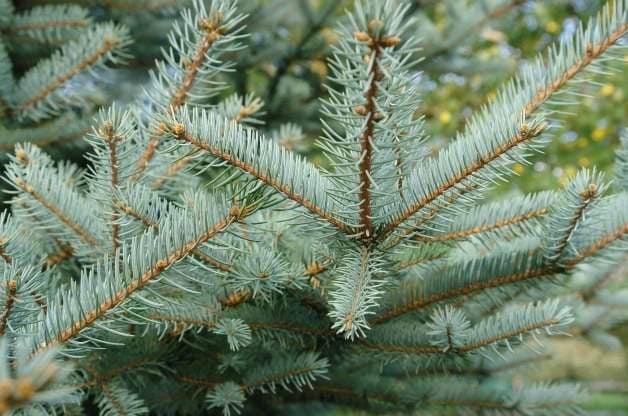
How to Choose and Plant Conifer Trees
Before you head to the nursery, it’s important to measure your planting sites, check your landscape for items you wish to block or spotlight. Then do a little research to determine which conifer types best suit your needs. Most conifers require well-drained soil in full sun. But a few, such as yews, arborvitae and hemlocks will tolerate shady sites.
“When buying conifers, always consider where you’re going to be using them, the plant’s light requirements and its size at maturity,” says Geno. “You don’t want to have to move a conifer if it gets too big for its designated spot.”
Geno also suggests purchasing conifers from reputable nurseries and growers in your area. They’ll carry plants that are best suited to your growing zone. In autumn, you can plant conifers as long as you can work the soil, but be sure to allow the plants enough time to establish roots before the soil freezes. Dig planting holes about 6 to 12 inches wider than the root-ball and deep enough so that the top of the root-ball sits even with or about an inch above the ground. Place the conifer in the hole, fill with existing soil and water well.
“Remember to plant conifers with companions that have the same water and light requirements. Evergreens don’t need a lot of water, so you don’t want to plant them with hydrangeas or other moisture-loving plants,” says Geno. “Mulch around the root area, but keep the mulch away from the trunk. Give them a good watering as they head into winter. Winter’s winds can dry out the plants. Satisfy the plants’ requirements, and you’ll find that conifers are fairly easy to grow!
Best Types of Conifer Trees for Your Landscape
Looking for the right conifer for your backyard? We asked two conifer experts to give us their favorite choices for landscapes.
Rich Eyre of Rich’s Foxwillow Pines Nursery in Woodstock, Illinois, suggests using sun-loving, intermediate conifers, such as Colorado blue spruce (Picea pungens ‘Fastigiata’), Norway Spruce (Picea abies ‘Cupressina’) or white pine (Pinus strobus ‘Fastigiata’), and larger conifers, such as steel blue Colorado spruces (Picea pungens ‘Hoopsii’, ‘Thomsen’, and ‘Glauca Pendula’), to create visual barriers or to draw the eye out into the landscape. For shady spots, try taller cultivars of arborvitae (Thuja), yews (Taxus), or pyramidal hemlocks (Tsuga canadensis) such as ‘Lewis’ or ‘Geneva.’
Geno Neri or Neri Landscaping in St. Charles, Illinois, likes to arrange taller sun-loving junipers, such as the upright ‘Wichita Blue’ (Juniperus scopulorum ‘Wichita’) as a complementary-hued backdrop that allows the purple-leafed weigelia shrubs to shine. He’s also likely to tuck dwarf varieties of arborvitae into rock gardens and arrange spreading junipers as foundation plantings.
More Conifer Choices
Thanks to the wide array of dwarf conifer cultivars, clipped evergreen foundation edgings have given way to house-side groupings comprised of more natural shapes in stair-stepped heights. Try arranging spreading golden Chines junipers, such as Juniperus chinensis ‘Saybrook Gold’, along with a rounded semi-dwarf golden mugo pine (Pinus mugo ‘Aurea’) for a golden glow. Add in a silvery-blue Colorado spruce such as ‘Montgomery’ (Picea pungens ‘Montgomery’), a greenish-blue rounded ‘Blue shag’ Eastern white pine (Pinus strobus ‘Blue Shag’) and earth-hugging blue rug juniper (Juniperus horizontalis) for contrasting colors and forms.
For a high-impact budget-minded entry garden, Eyre suggests combining boulders and dwarf perennials with inexpensive Norway spruce varieties, including Picea abies ‘Pumila’, ‘Repens’ and ‘Elegans,’ that will spread to 3 feet but only reach 2 feet in height in 10 years.
Small columnar conifers that work well as focal points in rock and alpine-type gardens include common junipers (Juniperus communis) such as ‘Pencil Point’ and ‘Compressa’. For areas receiving only 4 to 5 hours of sun, try a pyramidal blue Swiss stone pine such as ‘Glauca’ (Pinus cembra ‘Glauca’) or a dwarf bluish columnar Douglas fir like ‘Fastigiata’ (Pseudotsuga menziesii ‘Fastigiata’).
Stop strolling-by neighbors in their tracks by planting dramatically draped conifers that feature weeping growth habits. Trailing evergreen boughs, cascading downward from the trunk, make conifers such as Picea abies ‘Pendula’ and ‘Frohburg’ and Picea pungens ‘Glauca Pendula’ sensational specimen plants.
Next, check out the types of Christmas trees you can grow.
It’s easy to see why conifers are a staple of most backyard landscapes. They provide reliable shelter for birds, offer nice color and year-round structure in the garden and are mostly maintenance-free. Now you can have those same virtues in a smaller package, thanks to newer downsized varieties. While often referred to as “dwarf conifers,” many of these are technically just slow growers.
They will eventually get larger in 20 or 30 years, but most stay fairly compact and are classified based on their growth rate and size at 10 years. With the help of conifer expert and author Richard L. Bitner (Timber Press Pocket Guide to Conifers), we put together this Top 10 list of dwarf conifers, specifically with small space gardening in mind.
On This Page
Norway Spruce
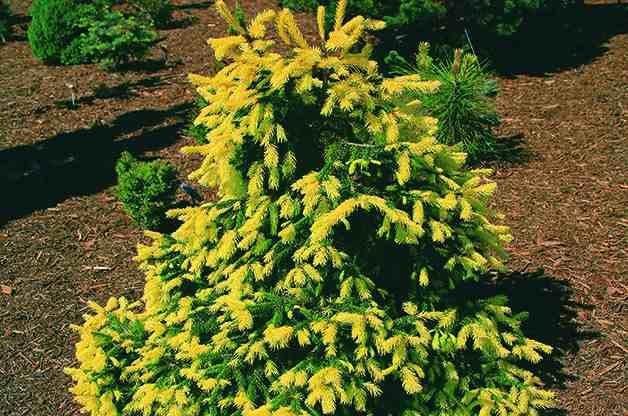
(Picea abies species, Zones 3 to 7)
This popular spruce has a pyramidal shape with shiny dark-green foliage. It prefers full sun, but adapts well to a variety of soil conditions and will tolerate wind. For years, it’s been a favorite fast-growing tree for large landscapes, but now gardeners are starting to look for dwarf cultivars as well. Some of the top choices include Clanbrassiliana, Echiniformis, Little Gem and Perry’s Gold (pictured).
Why we love it: The horticulture world has embraced this plant, so it’s easier to find than some other small conifers.
Check out the top 10 quick-growing shrubs.
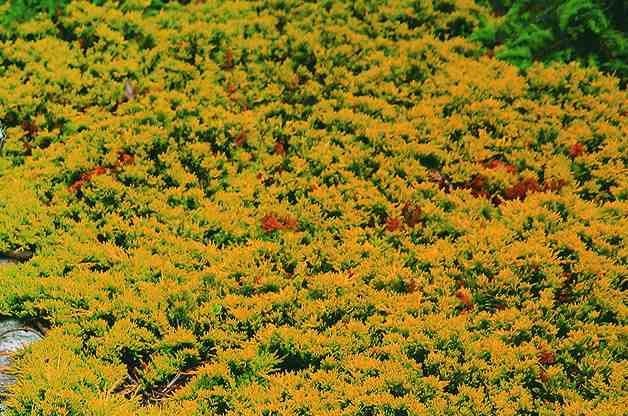
Creeping Juniper
(Juniperus horizontalis species, Zones 4 to 9)
This North American native grows well in just about any soil and is a popular choice for mountain slopes and seashores. Like other junipers, it prefers full sun and good drainage. Top picks include the blue-green Icee Blue, and Mother Lode (pictured), with its golden color in summer.
Why we love it: We’re always big fans of plants with dual benefits. With this one, you can have your conifer and ground cover, too!
Love evergreens? Discover the types of Christmas trees you can grow.
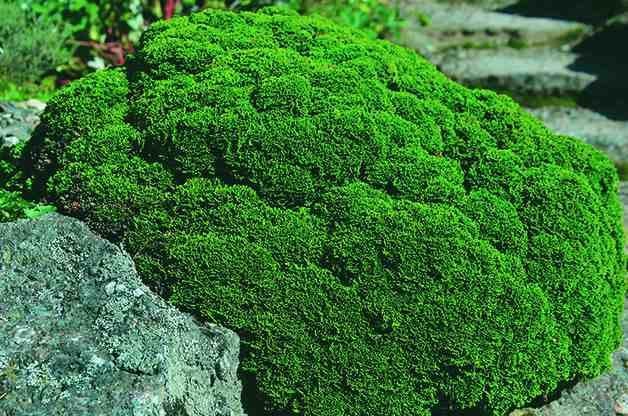
Hinoki False Cypress
(Chamaecyparis obtusa species, Zones 5 to 8)
If you need a conifer to provide unique form and texture, this is an excellent choice. A native of Japan, considered -sacred in the Shinto religion, it has dark-green fan- or shell-shaped foliage and interesting bark. For a small space, try slow-growing cultivars like Minima (pictured), the golden Nana Aurea and the glossy green Nana Gracilis.
Why we love it: This dwarf conifer is among the best of small conifers. Check a nursery or look online to find a cultivar that meets your needs.
Discover attractive drought-tolerant shrubs for your garden.
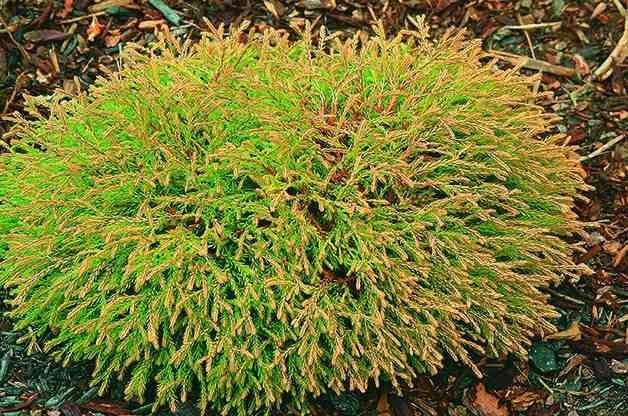
Arborvitae
(Thuja occidentalis, Zones 3 to 7)
This popular species is easy to find almost anywhere. But if you have deer in your area, beware. They love to munch on the foliage! The tree is dense, with a pyramidal shape and clusters of small seed-bearing cones. Smaller cultivars include Golden Globe, Hetz Midget and Tiny Tim.
Why we love it: It has a classic conifer look, provides generous coverage for birds and offers plenty of cultivars to choose from.
Problems with deer? Try these deer-resistant bulbs for spring blooms.
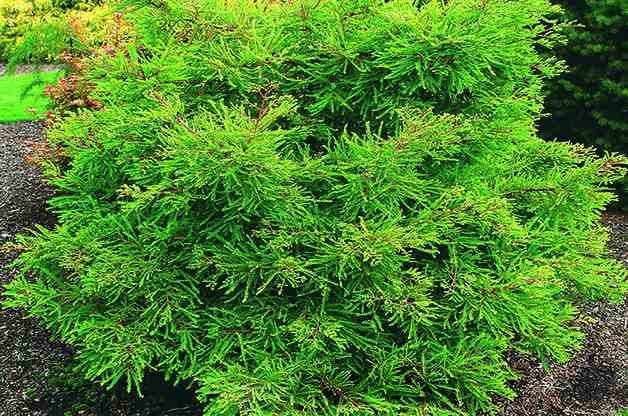
Bald Cypress
(Taxodium distichum, Zones 4 to 11)
Look for dwarf types of this deciduous tree that is found in the swamps of the eastern half of the U.S. (It’s also the state tree of Louisiana.) Bald cypress needs full sun and prefers moist, acidic, sandy soils. But what sets it apart is its availability to handle a variety of moisture conditions, even tolerating standing water. Slow-growing species include Cascade Falls, which is a compact weeping conifer. Also, Secrest is a nice flat-topped cultivar.
Why we love it: This tough conifer can handle wet and poorly drained sites. Also, it has beautiful orange to pumpkin-brown fall color before the needles drop.
Did you know you can use evergreen trees and shrubs to create winter shelter for birds?
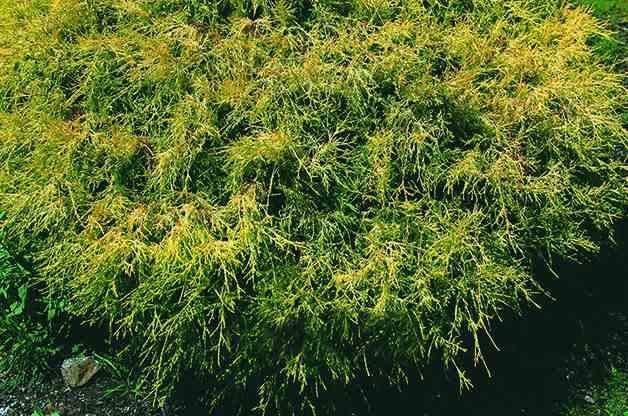
Sawara Cypress
(Chamaecyparis pisifera, Zones 4 to 8)
The cultivars of this species vary widely, with the large versions growing up to 150 feet in natural settings. Good cultivars for a small landscape include Filifera Aurea, with golden-yellow foliage that makes it an attractive border plant. Also try Golden Mop, a low and mounding variety with threadlike foliage.
Why we love it: If you do a little research, you can find dwarf varieties in all kinds of shapes and sizes, including shades of green, blue, yellow, white and variegated.
Psst—here are the things you need to know before planting a tree.
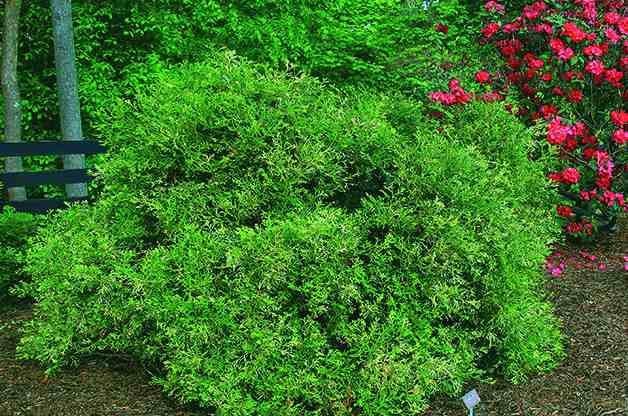
Hiba Arborvitae
(Thujopsis dolobrata species and cultivars, Zones 5 to 7)
A native of Japan, this conifer has large, broad branchlets with glossy leaves. It’s often used for hedging and is a versatile backyard plant. It’s not as common as other conifers, but it’s definitely worth a chance in your yard. Look for the compact form, Nana.
Why we love it: It tolerates a wide range of soils and does best in partial shade, making it a natural choice for many mature backyards.
Don’t miss the top 10 flowering shrubs that birds and butterflies love.
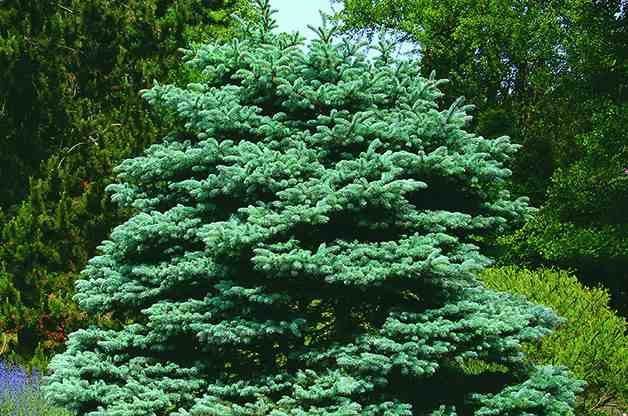
Dwarf Colorado Blue Spruce
(Picea pungens species, Zones 3 to 7, 8 to 9 on West Coast)
This Colorado native prefers rich, moist soils and full sun, though it is more drought-tolerant and adaptable than other spruces. Avoid insects, mites and diseases by finding a suitable location and providing proper care. Montgomery is a compact dwarf blue conifer that does well in most yards.
Why we love it: The stiff needles and elegant shape make it a standout in any yard. Check with your local extension office or nursery to find out what works well in your area.
Plant spruce trees to attract crossbills, the ultimate nomads of the bird world.
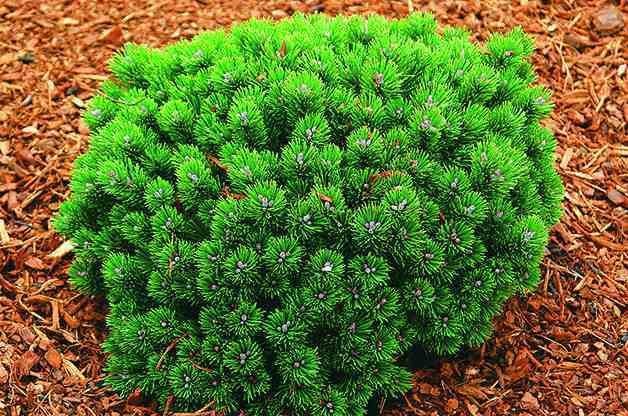
Mugo Pine
(Pinus mugo, Zones 2 to 7)
Dwarf mugo cultivars are most common but the species can grow 20 or even 30 feet tall. Mugos come in many varieties, including dwarf, upright and ground-hugging. Pine needle scale is common and can be a problem. Watch for disease problems in hot, humid summers. Top dwarf picks include Corley’s Mat, Sherwood Compact and Slowmound.
Why we love it: It’s one of the hardiest conifers available, thriving even in Zone 2! It also adapts well to many conditions and tolerates wind, drought and heat.
Learn about the top 10 tree diseases (and what to do about them).
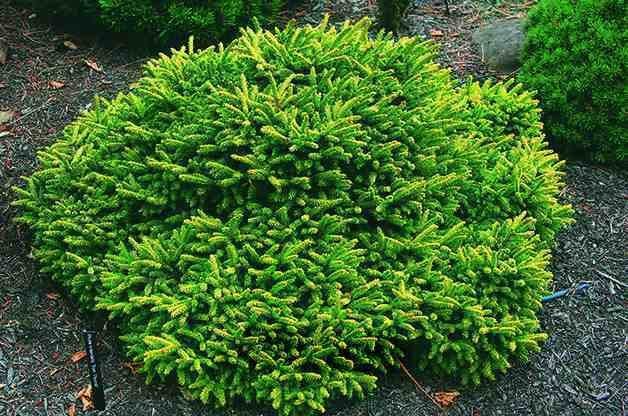
Oriental Spruce
(Picea orientalis species, Zones 4 to 7)
While Norway spruce is a favorite of many gardeners, the oriental spruce tends to be a better alternative. The needles are glossy green and soft to the touch. For smaller gardens, look for slow-growing cultivars like Nana (usually stays under 3 feet high), or Tom Thumb, with golden foliage.
Why we love it: It’s very tolerant! While you might have to protect it a bit during winter, it will tolerate some shade, drought and wind.
Love colorful fall foliage? Check out the best fall shrubs to grow.
1. What Do Silver-Spotted Skippers Look Like?
To identify these butterflies, it’s important to know their size and markings. Silver-spotted skippers have a wingspan of 1 3/4 to 2 1/4 inches. The upperside of the wings is dark brown with a long golden orange section toward the center. The hindwings have a prominent silver-white spot.
Need more help identifying butterflies? Here’s a cheat sheet.
2. Where to Find Silver-Spotted Skippers
The silver-spotted skipper is found in most of the continental U.S. and southern Canada near roadsides, gardens, fields and woodland edges.
3. How to Attract Silver-Spotted Skippers
Plant common milkweed, blazing star and thistles to attract more silver-spotted skippers to your garden. Check out these 16 long-blooming flowers for attracting butterflies and hummingbirds.
4. Where Do Silver-Spotted Skippers Lay Eggs?
Their host plants include black locust, false indigo, American wisteria and honey locust. Females lay single green (sometimes appearing white) eggs on or near the plants.
5. What Silver-Spotted Skipper Caterpillars Look Like
A yellow body and a brown-red head with bold eye spots help skipper caterpillars stand out. To attract more butterflies to your backyard, plant at caterpillar cafe in your garden.
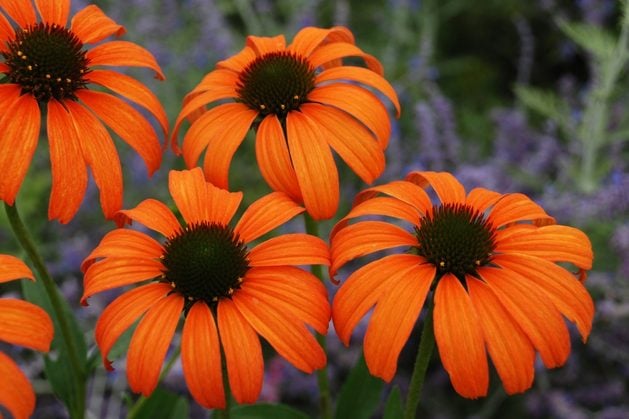
I’m a huge supporter of local nurseries and garden centers. I also like to support my area garden groups and plant sales. But as any plant geek knows, you can’t get all of your needs met in one place. People often ask me for recommendations on where to order plants online. It’s helpful for gardeners to know about the best online plant retailers. I pulled together my list of companies that I’ve personally ordered plants from, so I can definitely vouch for them. I like them for all different reasons, and I hope they help meet some of your needs as well. Because if there’s one thing every gardener needs, it’s more plants!
Great Garden Plants
Most of their plants are in big pots, and they are very healthy. They have many plant options available, but they are especially fantastic for unique coneflower varieties. Also check out the 7 best sources for buying flower bulbs online.
Bluestone Perennials
I started the garden in the front of my house with one of Bluestone Perennial’s pre-planned gardens. Don’t be afraid to try one of these kits. They are awesome, focusing on plants that are easy and low-maintenance. Then you can fill in as needed. Psst—check out 10 easy-to-grow houseplants all plant parents need.
Annie’s Annuals
They have great selection of annual plants. I once bought my mother-in-law some unique sunflowers from Annie’s. (It’s not always easy to find plants instead of seeds.) They have some really cool varieties. Check out the plants and gardening supplies we can’t stop buying on Amazon.
Logee’s
They specialize in fruiting, rare, and tropical plants. I bought my mom a lemon tree from Logee’s one year, and I have my eye on an avocado next. Check them out for unique options when you want to order plants online. Learn how to overwinter tropical plants.
Burpee
They are still one of my go-to sources for ordering veggie plants and seeds online. If you’re looking for something specific for your vegetable garden, they probably have it. If you’re new at vegetable gardening, try the top 10 easy-to-grow vegetables.
Breck’s
Breck’s is well known as a retailer of bulbs, from daffodils to dahlias, but also check out their large selection of perennials and shrubs.
Butterfly Bushes
They have the best selection of butterfly bushes that I’ve ever seen, and they offer many great varieties of flowering shrubs like viburnum and dogwood. Learn how to care for and prune butterfly bush.
Terroir Seeds (Underwood Gardens)
The couple that own Terroir Seeds are just delightful. We featured them a couple of years ago because they were one of the only places we could find that carried cucamelon seeds. Cucamelons are these adorable little veggie/fruits like a cross between a cucumber and a tiny little watermelon.
Next, shop for the canning supplies you need to preserve your favorite fruits and veggies.
